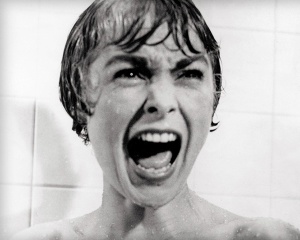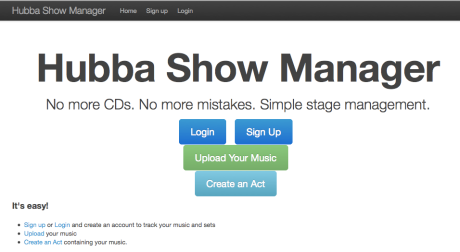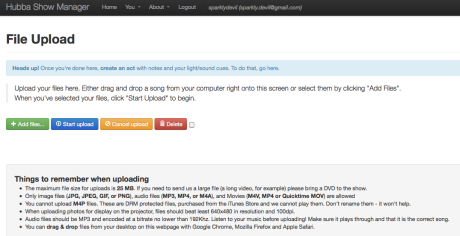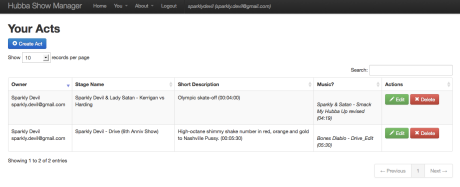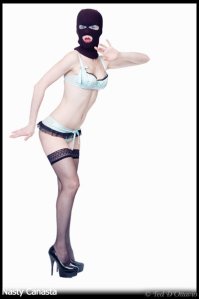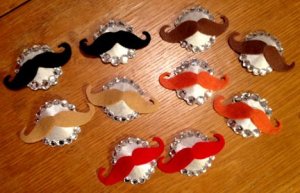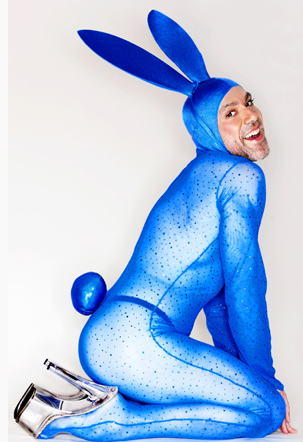Rule #1 of BHOF: Be prepared for anything. Including pool monsters.
It’s almost here! Burlesque Hall of Fame Weekend countdown has begun, as glitterati from across the globe test the limits of their suitcases and prepare to descend on Las Vegas for four (or more) days of jam-packed glamour, showcases, classes and parties.
Last year I wrote my first-ever BHOF Survival Guide; there have been some exciting new additions to the Weekender, so I’ve put together an amended and improved version for 2013. So, without further ado:
The BHOF Survival Guide v2.0
In just a few days, hundreds of performers and fans from across the globe will descend upon Las Vegas for the largest and oldest burlesque competition — which is also the primary fundraiser for the world’s ONLY non-profit museum dedicated to preserving the history of burlesque as an art form.
In addition to a reunion and four nights of jaw-dropping performances, there are daytime activities, group outings, pre-parties, after-parties, and hob-nobbing galore. This is one big crazy weekend overflowing with glitz, glam, glitter and sensory overload.
And although BHOF is a delight for the soul, it can also wreak havoc on your body. I’ve been going since 2003; and I still haven’t learned how to pack properly or bring the right shoes. (Edit: this will be the year I conquer the fucking shoe issue, I swear) However, here are a few bits of wisdom that I’ve accumulated over the years, which will hopefully guide you through the next few days, whether you’re a BHOF virgin or a veteran of Helendale.
DRINK WATER
No, seriously. Drink WAY more water than you think you need, all day, all night. Do not skimp on the water. Pretend you’re at Burning Man. Pee clear at all times.
Dehydration is the #1 cause of BHOF crankiness and exhaustion. It’s hot as hell in Vegas in June, you’re in the desert, and going from the pavement-melting indoors to the brisk chill of the A/C in the casino is going to affect you. Bling a water bottle, and carry it with you all day. If you’re drinking alcohol, have a glass of water in between each drink. Even if you’re not drinking alcohol, hit that H2O hard.
BRING COMFY SHOES
I CANNOT STRESS THIS ONE ENOUGH! Last year I was publicly busted for flagrantly ignoring my own advice, and wound up paying the price dearly: I had to fill the tub in my room with ice and shove my feet in while howling in pain, for a few days in a row. I vow to not repeat this in 2013!
Here’s the thing: you’re either a foot sweller, or you’re not. If you’re a sweller, you probably already have an inclination: if you have trouble removing your rings after a tough workout or when you’re dehydrated, you’re a sweller. Add to that the combination of air travel + desert & dehydration + impractical heels, and you will wind up with the curse of Las Vegas Blimp Foot (or, as my husband lovingly calls them, Eggplant Feet.)
If you’re a sweller: bring kitten heels, open-toed shoes, strappy sandals made of stretchy material – anything that will accommodate for swelling. If you can stand it, give your feet daily ice baths (or just soak them in the Orleans pool first thing in the morning, which will be pretty much the same temperature.)
If you’re not a sweller: you’re still not scott-free! Don’t wind up with crippling foot pain or searing blisters; make sure you have moleskin and Dr. Scholl’s inserts on hand. And for cripes sake, don’t break in a new pair of shoes in Vegas!
MEET THE LEGENDS
Again, I can’t emphasize this enough! Seek out the legends and strike up a conversation. Offer to buy them a drink, a cup of coffee, or a meal. Some of them may be a little shy, just like you – so just introduce yourself with a big smile, tell them where you’re from, and ask them a question or two. This is your chance to hear the stories of how it used to be firsthand from the ladies who lived it. And you can learn a trick or two from them at the BHOF Finishing School classes.
SEE THE MUSEUM
New this year: The Shimmy Shuttle will bring you to the The Burlesque Hall of Fame Museum and back for a mere $10. The shuttle runs on Friday and Saturday only, and you must buy advance tickets, which you can do at the link above. If there is a one must not miss off-site event of the weekend, it’s this. Remember the entire Weekender is the primary fundraiser for the museum, so this is why we’re all here, folks!
The museum is located inside the Emergency Arts building, in historic downtown Las Vegas on Fremont Street. This area is commonly known as “Old Vegas” and is a lot of fun to wander around. Each shuttle will give you a 90-minute window between arrival and departure, so you’ll have plenty of time to hit the museum and do a little exploring of the area, too. Here’s a description of the current exhibition, from Executive Director Dustin Wax:
“Not-So-Hidden Histories: Performers of Color in Burlesque”
“The history of burlesque is full of women (and some men) of color. Black, Asian, Latina, South Pacific Islander, and Native American dancers were very much a part of burlesque history, and not just as chorus girls for white headliners. They were integral players in the history of burlesque. Among the first to shamelessly bump and grind, performers of color left an indelible mark on burlesque history. Many achieved enough fame to work on the Minsky circuit, earn $1000 or more a week, insure their bodies, tour the US and Europe, and work with (and date) prominent entertainers such as Dizzy Gillespie, Sammy Davis Jr., and Little Richard. These performers not only existed but, in many cases, they thrived.”
TWEET IT UP
Use the official hashtag of #BHOF when Tweeting & Instagramming your adventures – this helps drive awareness for the museum, and your enthusiasm will be infectious! We’re trying to achieve critical mass and get #BHOF trending on Twitter during the Weekender, so the more you Tweet, the better!
BE KIND TO YOUR BODY
Take multi-vitamins daily, drink that water, and try to get a minimum of 5 hours of sleep a night.
If you’re a vegetarian, on a budget, a fussy eater or just not a fan of the buffet, you can rent a fridge from the Orleans for $15 a day and hit up the local grocery store for supplies. Alternately, you can grab a big styrofoam cooler from the liquor store around the corner and keep it filled with ice, for both your carrot sticks and your booze.
If you’re looking to exercise something other than the fortitude of your liver: there’s the Orleans gym, a 24-Hour Fitness down the road, and there will be a room set aside for group fitness every morning from 9-10:30am, in Big Al’s Comedy Club. More details TBA!
BHOF is notorious for the all-day-into-late-night parties; it’s tempting to go balls-out for the first day or two, but you don’t want to crash-and-burn by Saturday afternoon. It’s a mini-marathon, not a sprint. Pace yourself, you’re in it for the long haul!
But if you don’t drink or recently stopped, don’t fret – you’re not alone! Plenty of people who don’t drink go to BHOF and have an amazing time. If you’d like to meet up with some of them, there will be some on-site meetings for those in recovery who are attending BHOF. Follow @bhofbill on Twitter for more information.
BOOK DATE TIME
If you’re traveling with your boyfriend/girlfriend/partner/spouse, make sure your S.O. is attended to and has what s/he needs to stay entertained and happy. Try to book something alone time for just the two of you, whether it’s watching the fountains at the Bellagio or enjoying a nice meal together away from the hustle & bustle of festival.
HIT THE STRIP
The Orleans offers a free shuttle to the main drag of Las Vegas, known as “the Strip.” Here’s where you’ll find clusters of big casinos, tourist traps, mile-high plastic cups in silly shapes, and all of the other delightfully tacky glitz that Vegas is known for. Check out these free attractions for more great stuff to do and see that won’t cost you a dime.
GO SHOPPING
Don’t forget to hit the BHOF Bazaar! Beyond that, if you’ve got the bling bug and you’re looking to get your shop on, here are a couple of great spots:
–Fantastik Indoor Swap Meet – Open Friday, Saturday and Sunday, 10am – 6pm. This isn’t a swap meet, but a huge indoor flea market that’s like heaven for drag queens and burlesque chicks. You’ll find $1 lashes, cheap hair flowers, wigs, sparkly heels, costume jewelry, dresses, knives, churros, and god knows what else. This is also where you can find the customized rhinestone name necklaces that now serve as the defacto BHOF nametag – you can get them in the DuBarry’s booth. Get a group to share a cab over; be warned that it’s easy to catch a cab there, but pickup will take a lot longer, so keep that in mind if you need to be back at a specific time.
–DuBarry’s – DuBarry’s has a huge booth at Fantastik, but if you still want even more rhinestoned bling, check out their brick & mortar store. It’s packed to the bursting point with costume jewelry, accessories and fabulousness. There’s also free music and champagne on Sundays.
–William’s Costume Company. Outstanding collection of unique trims, chainette fringe, and a large selection of rhinestones, plus lots of assorted costumes, props and ridiculousness. Ask for Glenda the Rhinestone Lady, and tell her you want to see her collection of rhinestone handiwork.
REMEMBER TO PACK
-Your ID! You need it to pick up your tickets!
-Lotion, moisturizer, chapstick, and baby powder if you’re prone to chafing. You will feel like a lizard come Sunday.
-Sunscreen, parasols and floppy hats; shade is limited at the Orleans pool.
-Waterproof mascara & Kleenex for the Friday night Legends showcase. You will cry.
-Your business cards & flyers.
-Light cardigans and shawls to cover up in the cold casino.
JUST BREATHE
If you’re performing during the weekend, you might be a little stressed. Or freaked out. Or you might be in full-blown meltdown mode….so just take a minute to breathe. It’s natural to be a little stressed out, so set aside some just-you time to unwind and relax before your performance: take a quiet bubble bath in your room, find a secluded part of the pool to get in some reading, or book some time at the spa. Remember, you’re here to have FUN, right? Just go with the flow, don’t sweat the little shit, slap on another layer of sparkle, and be fucking fabulous!
I’ll see all of you in VEGAS, BABY! And if you catch me in uncomfortable shoes, you have my permission to document it and publicly shame me via social media. Game on.


